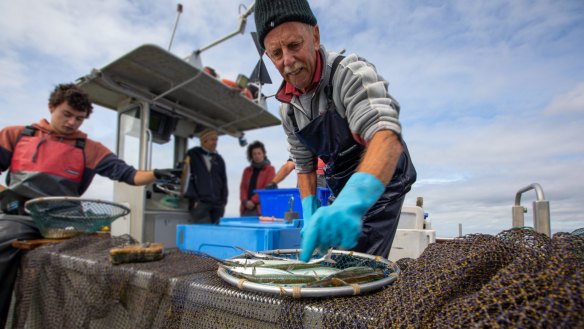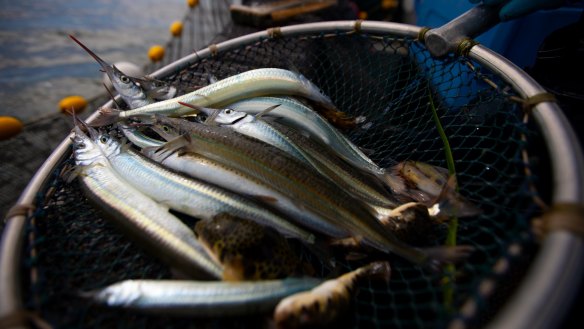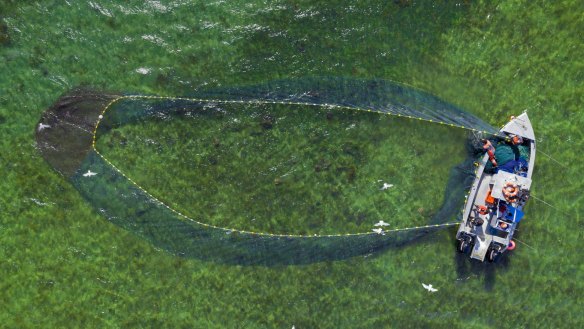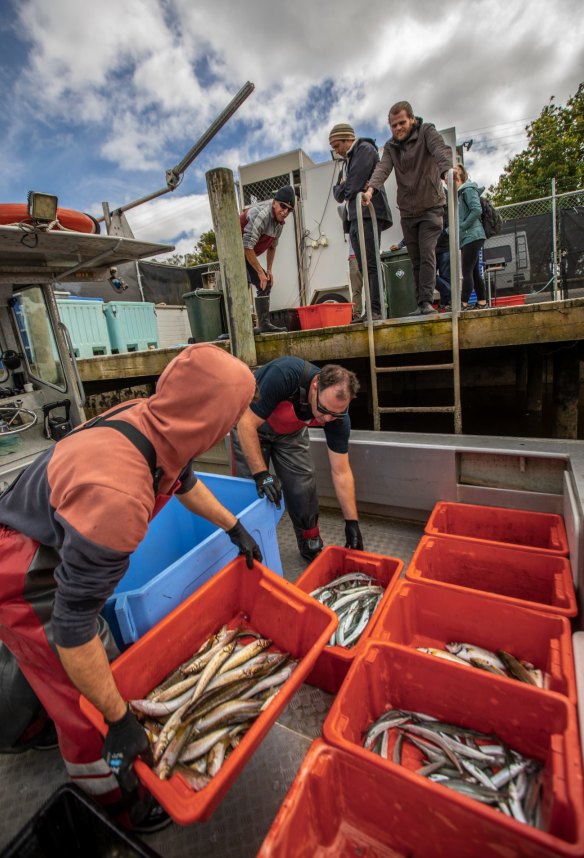Access to prized Victorian seafood under threat say fishers

Third-generation commercial fisherman Neville Clarke leans over the side of his boat and dips a hoop net into metre-deep water. The 66-year-old is at Corner Inlet off the coast of Gippsland, 160 kilometres south-east of Melbourne.
Clarke pulls up his net and it's busy with wriggling garfish, glossy calamari and a puffer fish expanding like a balloon. Clarke sorts the fish with practiced hand and careful eye: the puffer is tipped back into the sea to deflate and swim away. Eating fish are slipped into an ice slurry in a plastic tub on the boat's deck. Undersized garfish are placed back into the inlet. "See you next year," says Clarke to the spike-nosed juveniles, though he's deeply concerned about how many "next years" there will be.
Port Phillip Bay was closed to commercial fishing after the 2014 state election, as part of the government's $46 million commitment towards recreational angling, which aims to grow participation to one million people by 2020. The Gippsland Lakes waterways are poised for commercial fishing shutdown following the 2018 election, and now licensed fishers at Corner Inlet are concerned the next election will foreshadow the end of their industry. This would end the Victorian public's access to commercially fished local bay and inlet seafood.

The government's official position is in favour of Corner Inlet. "We have a fantastic fishery there," says Travis Dowling, chief executive of the Victorian Fisheries Authority. "Some recreational fishers have reached out to us saying they have concerns about commercial fishing impact there but we will continue to support it."
Fishermen such as Clarke are still concerned. "There are only 18 of us," he says. "Even though we feed a lot of people, we are a small minority among the thousands of recreational fishers. I don't have any conflict with the recreationals - there's good and bad among all types - and I believe there's room here for both sustainable commercial [fishing] and recreational."
As it stands, Corner Inlet is Victoria's last remaining bay and inlet fishery, producing around 320 tonnes of seafood annually. It's a minnow in Victoria's 19,000-tonne wild-caught industry, most of it ocean caught, but the fish is prized for its quality and, due to its proximity to Melbourne, its freshness. The inlet's King George whiting, southern garfish, rock flathead and southern calamari are sought after by chefs including Neil Perry and Attica's Ben Shewry.

Neville Clarke fishes using seine nets with the environment top of mind. A 650-metre net with floats on the top and weights on the bottom is '"shot" from the boat which slowly arcs around, looping the net into a circle. Fish are herded gently towards the boat, then scooped in by hand for sorting.
Government catch, gear and reporting regulations are topped up by a voluntary code of conduct that, for example, means compliant fishers send nets out only twice in any 24-hour period. Most in Corner Inlet already abide by the code, but Clarke would support legislation to enshrine it. "When did you ever hear of a fisherman asking for more rules?"
He says such legislation would not only ensure the fishery's sustainability, it would give commercial license holders some certainty about their future.

"We fish to preserve the inlet environment and ensure there are plenty of fish for tomorrow. But the government has demonstrated that they don't care much for these small fisheries. We are the last one remaining and we feel like sitting ducks."
Johnathon Davey is executive director of Seafood Industry Victoria, which represents commercial fishers. He notes that Victoria already imports 80 per cent of its seafood. "We do not have the local industry that we should have," he says. "Victorian produce is a point of pride for our state but some government policies make it very hard to follow through on that as a consumer of seafood, or as a chef."
Davey says there are misconceptions about sustainability and commercial fishing. "People tend to have the impression that all commercial net fishing is bad, but we know that when it's done well, it is sustainable. Fishers can be extremely selective, hand-sorting the fish and releasing unwanted fish alive."
If Corner Inlet is closed for commercial fishing, Victorians who don't fish themselves will no longer have access to local calamari, King George whiting or rock flathead.
"It would be catastrophic," says Davey. "Victoria's bay and inlet fisheries are treasures that should be fished sustainably for the benefit of all Victorians, and that includes the 18 commercial fishermen at Corner Inlet who at the moment feel like their heads are on the chopping block."
Dani Valent travelled to Corner Inlet with Good Fish Project
Restaurant reviews, news and the hottest openings served to your inbox.
Sign up